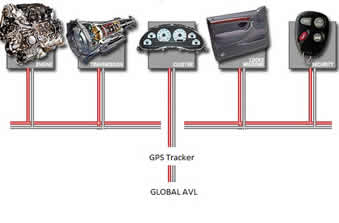What data can be obtained through the Can Bus?
The amount of data depend primarily on (i) the standard of Can Bus offered by the vehicle itself and (ii) which such data are available.
In generic terms, these data are:

- Fuel level shown in the dashboard
- Total fuel consumption
- instant consumption
- Engine Temperature
- Total hours of engine use
- Ignition Status
- R.P.M.
- Engine Brake
- Clutch-Slave
- Own digital tachograph data such as vehicle ID, driver ID, signal conduction time or working position
- Speed based on the axes
- Speeding
- Driving Time
- Missing miles for the next service
In Global AVL and using our location platform offer various hardware options (GPS devices) to obtain data on the Can Bus FMS standard SAE J1939, 1708, 1587, Can or Can Bus Extended 2.0.
Be sure to contact us to know the makes and models of vehicles compatible with these GPS devices.
 Fuel Control
Fuel Control Logistics Module
Logistics Module Remote downloading of tachograph data
Remote downloading of tachograph data Vehicle event management
Vehicle event management Vehicle Preventative Maintenance
Vehicle Preventative Maintenance Dispatching
Dispatching Hours of Service Control (HoS)
Hours of Service Control (HoS) Eco Driving
Eco Driving Care Driving
Care Driving Driving Control
Driving Control Field Management
Field Management Scheduled Reports
Scheduled Reports Fleet Management Control
Fleet Management Control Mobile Applications
Mobile Applications Data forwarding
Data forwarding API
API GPS Vehicle Trackers
GPS Vehicle Trackers GPS Asset Trackers
GPS Asset Trackers GPS Personal Trackers
GPS Personal Trackers GPS Satellite Trackers
GPS Satellite Trackers IoT Devices
IoT Devices +34 911 460 719
+34 911 460 719 sales@globalavl.com
sales@globalavl.com